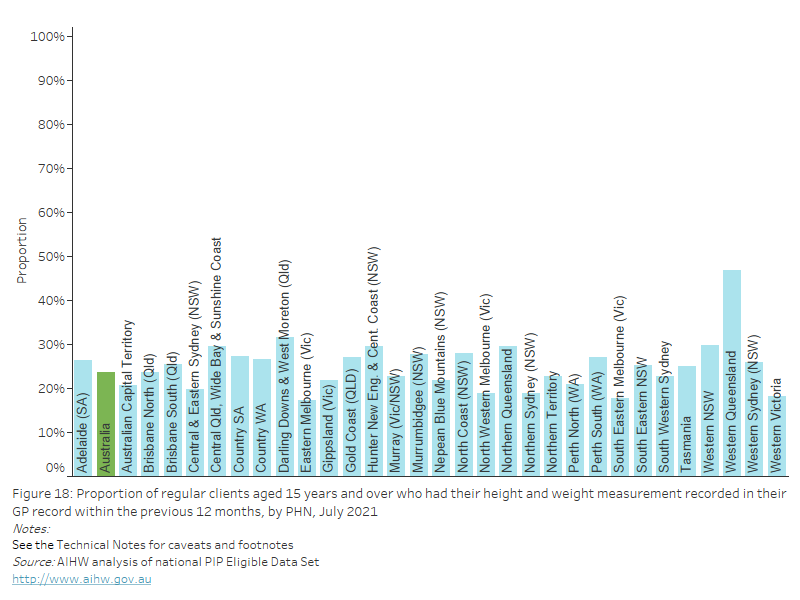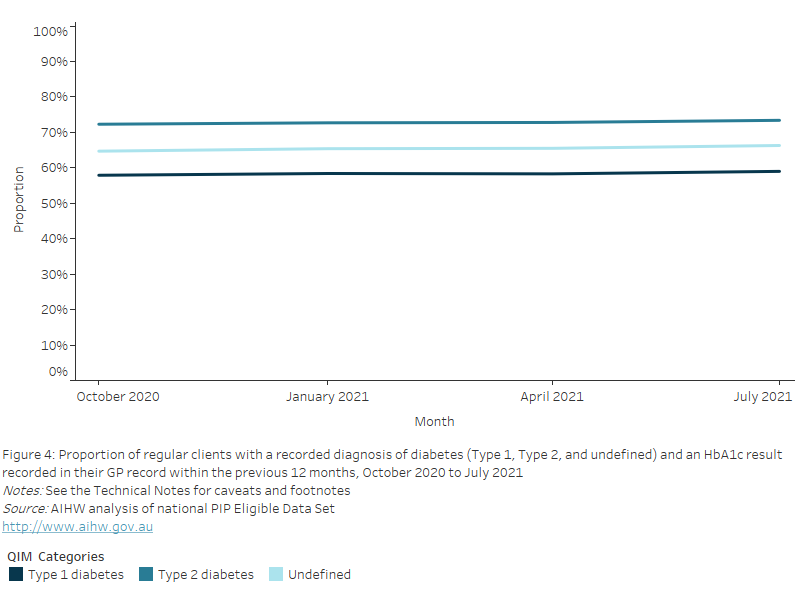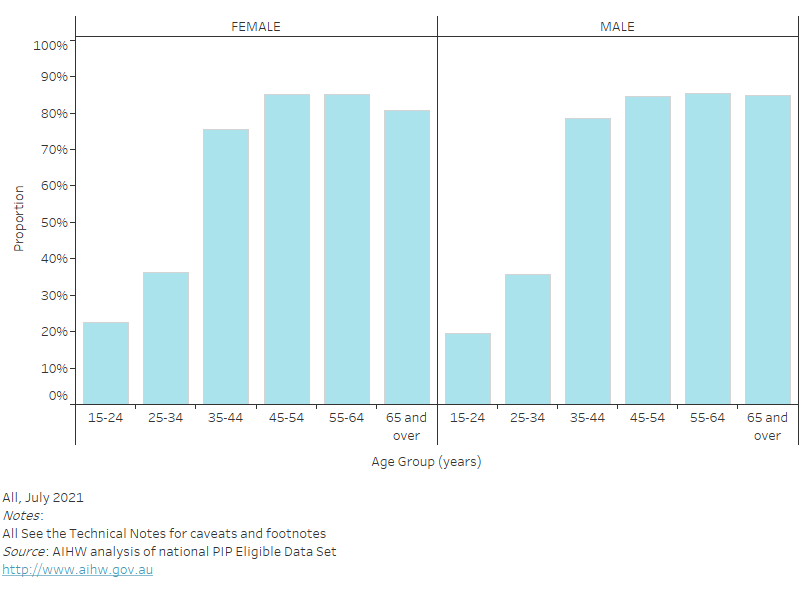QIM 6: Proportion of regular clients with COPD with an influenza immunisation status recorded in their GP record within the previous 15 months
Influenza is a common disease of the respiratory tract. It affects people of all ages. It is estimated that influenza is likely to be associated with more than 3,000 deaths and 13,500 hospitalisations each year in Australia, just in people aged >50 years (ATAGI 2018).
There are a number of groups who are at a higher risk of influenza and its complications. These groups experience higher illness and death associated with influenza than the rest of the population and patients with COPD is one of the vulnerable population groups. Therefore, annual influenza vaccination is strongly recommended for patients with COPD (ATAGI 2018).
People with COPD are considered to be at high risk of complications from influenza. Data from several studies also provide evidence that influenza vaccination has a clinically important protective effect on influenza-related COPD exacerbations, and probably an effect on the total number of exacerbations in COPD patients. The administration of influenza vaccine to persons at risk of complications is the single most important measure in preventing or attenuating influenza infection and preventing mortality. While best practice guidelines recommend annual immunisation, a 15 month interval allows for cases when a client decides to receive a vaccine earlier than recommended (e.g. from a pharmacy), or delay and wait for the release of an ‘enhanced’ vaccine (Department of Health 2020).
Capture of results recorded outside of the general practice setting
Some patients with COPD may receive care from other practitioners in addition to a GP including a specialist physician, and/or other health care providers to safely manage their COPD (Abramson et al. 2014). Results arising from clinical intervention conducted outside of the service that are known and recorded by the practice are included in the measure. Where the immunisation was provided elsewhere (for example, specialist centre, pharmacy, work place etc.) and the information is not recorded in the clinical information system of the client’s usual general practice (for example, due to incompatible clinical information system between a practice and another service), then these data will not be captured in the report.
Other sources of relevant data
Data on prevalence of long-term health conditions like COPD are captured in the National Health Survey (NHS) conducted by the Australian Bureau of Statistics (ABS). There are other administrative data collections where the data on influenza immunisation are captured, e.g. the Australian Immunisation Register (AIR).
This indicator reports on the proportion of regular clients aged 15 years and over with a chronic obstructive pulmonary disease (COPD) diagnosis, and who had an influenza immunisation status recorded in their GP record within the previous 15 months.
As of July 2021, nationally, 66.8% of regular clients aged 15 years and over with a COPD diagnosis, and with an influenza immunisation status recoded in their GP record within the previous 15 months. This varied between 52.8% and 75.5% across PHNs.
Figure 36: Proportion of regular clients aged 15 years and over with a COPD diagnosis with an influenza immunisation status recorded in their GP record within the previous 15 months, by PHN, July 2021

Nationally, between October 2020 and July 2021, the proportion of regular clients with a COPD diagnosis who had an influenza immunisation status recorded in their GP record within the previous 15 months, increased by 5.9%, from 60.9% to 66.8%.
Figure 37: Proportion of regular clients aged 15 years and over with a COPD diagnosis with an influenza immunisation status recorded in their GP record within the previous 15 months, October 2020 to July 2021

Proportion of regular clients with COPD with an influenza immunisation status recorded in their GP record with the previous 15 months by age and sex
The development of COPD occurs over many years and therefore affects mainly middle aged and older people. While it is occasionally reported in younger age groups, the prevalence of COPD increases with age, mostly occurring in people aged 45 and over (Abramson et al. 2014). In Australia the prevalence of COPD was estimated to be 7.5% for people aged 40 years and over and 30% for people aged 75 and over (AIHW 2020).
As of July 2021, nationally, the proportion of regular clients aged 15 years and over with a COPD diagnosis, who had an influenza immunisation status recorded in their GP record within the previous 15 months, increased with age and was:
- highest in the 65 years and over age group for both females (75.9%) and males (75.5%).
- lowest in the 15-24 years age group for females (23.7%) and in the 25–34 years age group for males (18.8%).
Figure 38: Proportion of regular clients aged 15 years and over with a COPD diagnosis with an influenza immunisation status recorded in their GP record within the previous 15 months, by age and sex, July 2021

- Chronic Obstructive Pulmonary Disease (COPD) includes any diagnosis of COPD.
- Clinical definitions for COPD vary across clinical information systems, as different coding schemes are used. This may lead to some variation in the number of clients who will be picked up by different systems (Department of Health 2017).
- Data for clients are included if they have received an influenza vaccine within the previous 15 months.
- Results arising from clinical intervention conducted outside of the service that are known and recorded by the service are included in the measure. Where immunisation was given elsewhere (for example, workplace, pharmacy etc.) and the information is not recorded in the electronic record of the client’s usual general practice, then this may result in an apparent missing information.
- Clients are excluded from the measure if they:
- did not have the immunisation due to documented medical reasons (e.g. allergy), system reasons (vaccine not available) or client reasons (e.g. refusal),
- had results from measurements conducted outside of the service which were not available to the service.
- There are other administrative data collections where the data on influenza immunisation are captured for example, the Australian Immunisation Register (AIR).
Abramson M, Frith P, Yang I, McDonald C, Hancock K, Jenkins S et al. 2014. COPD-X Concise Guide for Primary Care. Brisbane. Lung Foundation Australia. Viewed 12 August 2021.
AIHW 2020. Chronic obstructive pulmonary disease (COPD). Cat. no. ACM 35. Canberra: AIHW.
Australian Technical Advisory Group on Immunisation (ATAGI) 2018. Australian Immunisation Handbook, Australian Government Department of Health, Canberra. Viewed 12 August 2021.
Department of Health 2017. National Key Performance Indicators for Aboriginal and Torres Strait Islander primary health care - Data Validation Project Report. Canberra: Department of Health.
Department of Health 2020. PIPQI Improvement Measures Technical Specification v1.2 22102020. Viewed 12 August 2021.


